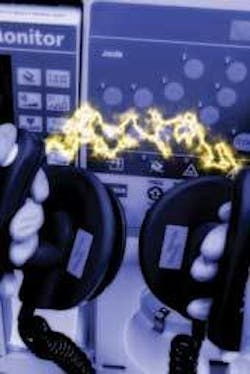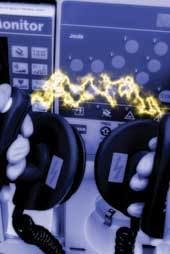Are you ready for L.I.F.E.?
by John B. Roberson, DMD, and Christopher M. Rothman, DDS
Webster’s Dictionary defines life as: “The time a person or thing exists;
The Institute of Medical Emergency Preparedness (IMEP) sees LIFE as:
Life-Saving
Instructions
For
Emergencies
Do you truly know what to do in the event of a medical emergency in your office or outside your office such as home or a restaurant? Now is the time for you to evaluate yourself, your staff, and your office. Make it a goal to get prepared and stay ready for that unexpected event.
Dr. Stanley Malamed, when speaking on medical emergencies, said that the general level of awareness and preparedness in the average general dentist office has always been poor. He states that emergency medicine lectures always draw a bigger crowd than his anesthesiology lectures, but he think it is in large part morbid curiosity. Everybody wants to know what to do. But even though many, many states require dentists to be CPR-certified for licensure, in reality most of us are not fully prepared to handle an emergency. Once you get beyond fainting, even though you may take your CPR class every two years, when something actually happens, you panic. And when you panic, nothing goes well.
Christina Hovliaras-Delozier, RDH, BS, MBA, commented, “If you haven’t had a medical emergency at work, consider yourself lucky. If you don’t have a plan, I encourage you to talk to your employer and team and put one into place. The recent sad news of the accidental death of five-year-old Diamond Brownbridge in September 2006 after receiving anesthesia for a dental procedure emphasizes that it is important to protect your patients and office team, and that the office not be exposed to a potential liability if something occurs and the emergency becomes a tragedy.”
Recent litigation against a health club in which a person died showed negligence on two parts: 1) no AED (Automated External Defibrillator), and 2) the health club’s failure to maintain an adequate safety plan for members in the event of a medical emergency. Dental offices and staff will be held to a higher standard than a health club when it comes to an emergency. Therefore, should the unthinkable happen in your dental office, would you be able to say you did all you could? Would you be able to prove you did all you could?
With local anesthetics administered by dentists everywhere and by hygienists in 38 states, it should be noted that the Package Insert with every box of local anesthetics from manufacturers such as Cook-Waite, DENTSPLY, and Septodont stresses the need for readiness on medical emergencies. The PI warning section states: “Dental practitioners who employ local anesthetic agents should be well versed in diagnosis and management of emergencies which may arise from their use. Resuscitative equipment, oxygen and other resuscitative drugs should be available for immediate use.”
Dr. Malamed addressed the frequency of emergencies in another interview in October 2006: “Surveys show that during the ’90s, 90 percent of dentists had one or more emergencies in their office.” Emergency-medicine lectures are being taught all over the country, and your dental team should frequent these annually.
Molly Urbancic, an ICU/ER nurse in Michigan, saw the Emergency Response System by the Institute of Medical Preparedness and said, “I can’t even count the number of patients I’ve had that would probably still be here if only a first responder had been prepared. As an ICU nurse, I know not all patients can be saved. But the ones who could have been but weren’t given the chance are always the ones that break my heart.
Complacency: the dentist’s nemesis
Complacency is the dentist’s nemesis because it can cause one to lose focus on preparedness. The Five Deadly Misconceptions as developed by IMEP are:
- A medical emergency will not happen to me.
- A medical emergency will not happen in the office.
- Calling 911/EMS is the answer.
- My staff and I won’t panic during a medical emergency.
- CPR is all we need to know.
Do you believe any of these statements? If so, you need to get prepared!
The American College of Emergency Physicians states on its Web site that seconds save lives in medical emergencies. The few minutes after an event occurs are frequently the most important. The Emergency Response System by IMEP refers to this as the ERS Zone or Emergency Response System Zone. The ERS Zone - when people are 10 minutes to life or death - describes the critical time between the onset of a medical emergency and the time when the professional first responder EMT arrives. It is during this critical time frame when the “very first ‘first responder,’” which could be the dentist, dental hygienist, dental assistant, or office staff, may have to act to save the life of someone entrusted to their care.
Dr. Arthur Pancioli, vice chairman of the Department of Emergency Medicine at the University of Cincinnati and NIH Stroke Team member, said, “As an emergency room physician I deal with emergencies every day. The office-based practitioner, when confronted with a medical emergency, will have to treat the emergency until someone arrives to assist them and transport the patient to an emergency room. It is your duty to be the utmost prepared and ready for that emergency when it happens. Life-threatening emergencies such as sudden cardiac arrest or anaphylaxis will have to be treated by you in the office in order for that patient to survive. Do not expect the EMS to be parked out in your parking lot waiting for your call. Until they arrive, you will have to maintain and sustain the life of that patient. I cannot begin to stress how important it is to remain calm and act quickly when confronted with a medical emergency.”
ACEP member Kathleen Clem, MD, stated, “The key is knowing what to do, remaining calm, and making a decision to act. You can make a difference in critical moments by remembering four important steps: prevent, prepare, recognize, and act.”
Calling 911 is not a plan - but only part of a plan!
Calling 911 should be an assigned role within the medical emergency plan. Do not contemplate about whether or not to call 911 when there is trouble. Remember, an EMS will not be at your office immediately. You will have to treat this emergency until an EMS arrives to take over the care. EMS/911 response times average more than nine minutes in urban centers and more than 15 minutes in rural areas.
The former United States Secretary of Health and Human Services and former Governor of Wisconsin Tommy Thompson, who is actively involved with Emergency Preparedness, said this after viewing the Emergency Response System, “Failing to prepare is preparing to fail. First responders from all levels must be fully prepared to deal with medical emergencies, and a program such as the ERS achieves that goal with those other than EMS personnel or paramedics who may find themselves in the position of being a first responder.”
Heather Colicchio, president of the Amercian Association of Dental Office Managers, said this about medical emergencies, “When a medical emergency occurs, it will not be just a doctor problem or a ‘back office’ problem, but an entire office problem. Each person will play a role in ensuring the safety of that patient! The response to a crisis should be a well-coordinated event that has the goal of everyone performing to the best of his or her ability under such a stressful time.
The role of the office manager is crucial because he or she must make sure, first of all, that a plan has been developed and, second, that everyone knows his or her role. An office without a plan for handling a medical emergency is on a collision course for failure. When dealing with patient care and safety, failure is not an option.”
The Institute of Medical Emergency Preparedness states, “Why let an unfortunate event such as a medical emergency jeopardize the integrity of your practice, risk your financial freedom, or compromise the life of a patient simply due to the team’s lack of preparedness?”
Anesthesiologist Dr. Lee Elliot said, “Having you and your staff professionally prepared to handle the unexpected medical emergency is the only way to run a truly responsible medical or dental office. Hoping that something bad will never happen is not a good plan. If you take care of enough patients, you will eventually have to face an emergency. When it happens, you and your staff must be ready to react and must know how to handle the situation. Be prepared with the Emergency Response System.
You will not be able to predict the outcome of a medical emergency, but your staff must be prepared for one. Now is the time to start! Develop a plan. Be prepared. Build a foundation of medical emergency preparedness for your office. Preparation is the key to readiness for a medical emergency in the office.Drs. John B. Roberson, DMD, and Christopher M. Rothman, DDS, are oral and maxillofacial surgeons who are in private practice. They are both Board Certified by the American Board of Oral & Maxillofacial Surgery and the National Dental Board of Anesthesiology.
Editor’s note: The authors of this article are the developers of the Emergency Response System and are the co-founders of the Institute of Medical Emergency Preparedness. The ERS is a comprehensive medical emergency preparedness package developed for dentists and their staff. The ERS may be viewed at www.emergencyactionguide.com. Contact Dr. Roberson at [email protected].
Drs. John B. Roberson, DMD, and Christopher M. Rothman, DDS, are oral and maxillofacial surgeons who are in private practice. They are both Board Certfied by the American Board of Oral & Maxillofacial Surgery and the National Dental Board of Anesthesiology.
Let’s look at the different types and frequencies of emergencies that occur annually:
- every 1.2 minutes someone dies of a sudden cardiac arrest
- every 20 seconds someone has a heart attack
- every 45 seconds someone has a stroke
- every 3.3 minutes someone dies from a stroke
- every 3 minutes someone has a seizure for the first time
- every 6.6 minutes someone has an anaphylactic reaction

